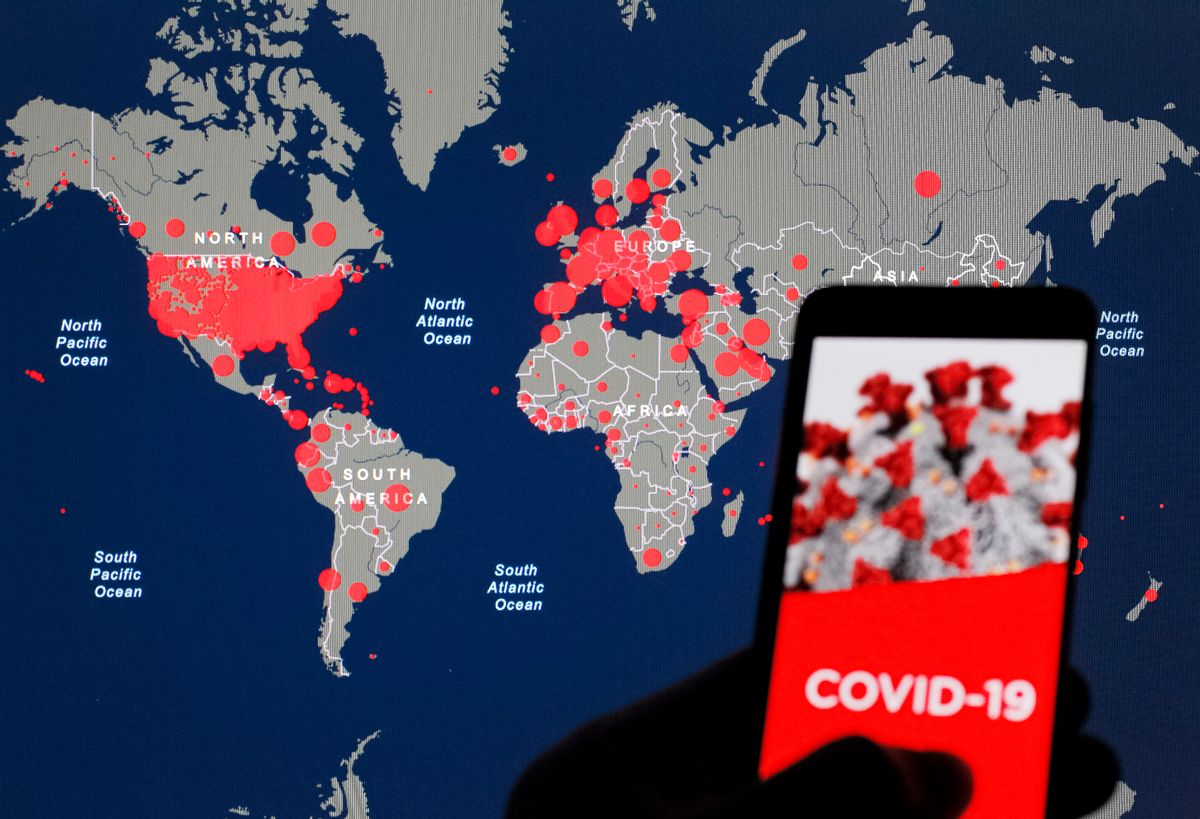Rewind to Feb. 3, 2020, in American news.
Beyonce and Jay-Z were making headlines for staying seated during the national anthem at Super Bowl LIV the day prior. Iowa Democrats were caucusing to help narrow a large field of presidential candidates including Joe Biden. U.S. Senators were just days away from acquitting then-President Donald Trump in his first impeachment trial.
Meanwhile, news reports documented the outbreak of a mysterious, deadly coronavirus infecting people in Wuhan, China. Roughly 425 people there had died so far.
“We still have a low risk to the American public, but we want to keep it at a low risk,” said Dr. Anthony Fauci, the country's top infectious disease expert, around that time, as reported by The Associated Press.
That status, of course, did not last long.
No predictions in those early days of the global outbreak could have forecast the virus' impact on American life: the deaths of almost 900,000 people, mass lockdowns, cultural divides over irrefutable science, economic uncertainty, and so on.
Two years later, that inability to predict the next steps of the naturally evolving virus — especially when factors such as human behavior (wearing masks, social distancing, etc.) were inextricably linked to its spread — persisted.
Snopes' research interest has also persisted.
To get a general sense of what the public can expect in the pandemic's third year (and possibly after that), we presented a series of questions to the above-pictured infectious disease experts. They are Dr. Andrew Karaba, of Johns Hopkins Medicine (left), and Dr. Amesh Adalja, of Johns Hopkins University Center for Health Security (right).
For example, we asked if they considered the highly contagious omicron strain was "nature's way of curbing" the crisis and whether they had any guesses on the number of vaccinations people will need for the best protection throughout 2022 or 2023.
Some key takeaways from our interviews, which you can read in detail below:
- Prepare for more, and likely modified, COVID-19 vaccinations. "It’s a real possibility that variant-specific vaccines will be part of the strategy going forward."
- It's unclear how often — or who — will need such shots in the future. "It's likely we will get to a place where some regular booster schedule is devised."
- It might not be possible to achieve so-called herd immunity. "[It's] a very ephemeral golden ticket, and not one that I'm going to hang my hat on."
- Public health officials' recommendations, like telling people in communities with substantial or high transmission rates to wear masks indoors, will change when the data do. "As cases fall, the current CDC guidance would no longer be applicable."
Here's our transcribed phone interview with Karaba, which has been edited for breadth and clarity:
Snopes: How often should people without symptoms plan to get tested? Some areas have had shortages of tests, which could mean problems for health care workers or immune-compromised people who really need them.
Karaba: A key variable to the answer is the availability of tests. If everybody in the country got a free test every week, then that's great; then we don't have to worry about whether or not people are taking tests away from people who "really need it." Certainly the availability is increasing, but it's still not where I know most public health officials would like it.
And then the other piece is an individual's exposure risk — the risk of transmitting the virus to people around them.
So, if you're a healthy, youngish person who works from home and sees a couple of friends who are also healthy outside of your home, and you're all vaccinated and boosted, then the utility of testing super frequently doesn't make a lot of sense. Especially if you're not going out to dinner or restaurants or places where you might be exposed.
But if you have kids in daycare or school, or a job that requires you to work in close contact with a lot of other people — or maybe you frequently see your elderly relatives or someone with an immunosuppressing condition like an organ transplant or cancer — then I think you need to be testing more frequently.
[See here for the Centers for Disease Control and Prevention's recommendations on testing.]
Snopes: Considering the amount of breakthrough infections with omicron, what can you share about the potential for variant-specific vaccines or variant-specific boosters in the future?
Karaba: Bill Hanage, an epidemiologist at the Harvard School of Public Health, has done some interesting modeling looking at the use of a monovalent vaccine, meaning it targets just one variant to the virus, versus a polyvalent vaccine, meaning it targets a couple of variants. That's certainly something that the vaccine makers are doing. Pfizer is already looking at an omicron-specific variant vaccine.
It's a real possibility that variant-specific vaccines will be part of the strategy going forward. When they're deployed, how often they're deployed, who really needs them — I think are all questions that are very much up in the air.
The problem is that, when you make a vaccine to one specific variant, it may do very well protecting a person from that variant, but it may do poorly against all the other variants. It doesn't make sense then to just deal with the problem that's in front of you and sacrifice the problem coming down the road six months from now. So, it's going to depend a lot on the variant and how they perform in clinical trials.
But I do think that some modifications to the vaccines we've been using are probably coming and just when and how they will be deployed is unknown right now.
Snopes: For healthy people seeking the most protection, how many shots will possibly be recommended in the coming year? Or, even next year? Is it going to be a round of boosters every six months? One vaccine per year?
Karaba: I don't think we're at a point where there's a general consensus. It's going to depend a lot on the variants and also how the pandemic continues to progress.
Right now, these sort of waves we're getting — it's not predictable like the flu. Every year, we can kind of say the flu season starts in November and it kind of peters out by March. And so you can pretty reliably just know when we need to get everybody a flu vaccine. But that's not how, right now, the SARS-CoV-2 in the COVID-19 pandemic are behaving. So, it's hard to say, 'Oh, every six months we need it, or every year.'
It's likely we will get to a place where some regular booster schedule is devised.
For some of the variants, the antibodies that researchers measure fall faster than against other variants. So that's why it's hard to predict a vaccine schedule. You may have one vaccine that protects you from a particular variant for six months and then another variant comes along and your vaccine protection only lasts four months. So what do you do in that case? It's something that people are actively studying and trying to figure out.
Snopes: What advice do you have for people living in communities that are largely ignoring public health recommendations to get vaccinated, wear masks, social distance, etc. as the pandemic continues?
Karaba: The patients I take care of are immunosuppressed and, even with vaccines, are often not as protected as we would like them to be. And if they get the infection — even omicron — they will likely end up in the hospital.
So that sort of attitude of like, 'Well, I'm tired of this, you know, ruining my life. I'm gonna do what I want and just get it over it.' I personally feel that's a pretty selfish attitude.
Even in colleges and in high schools there are kids who have immunosuppressive conditions, or have autoimmune conditions, that require them to take immunosuppressive medications. Those kids are at risk, and to flaunt that in their face by not wearing a mask or not taking their health seriously, I think that's really sad. That shows a lack of compassion for your fellow human.
Snopes: For awhile, herd immunity was touted as the "golden ticket" out of this crisis. Is that still the case going forward?
Karaba: We know that immunity, whether it's from being infected with the virus or getting a vaccine, wanes, and at some point you can be infected.
Achieving a level of herd immunity, or population level of immunity that would protect everybody, is dependent on how many people are actually immune from infection at any given time. And that is a function of how often people are getting infected or getting vaccines, and how fast their immunity is waning.
What if I told you that, once you get a vaccine, you are 100% immune, you cannot get infected, for one month. And, simultaneously, everyone in the world got that vaccine. So, for one month, no one could get infected.
But now imagine that there was one person who had the infection and didn't get the vaccine. A month later, they're going to start spreading it again as people's immunity starts to wane.
That's an extreme case. But we don't really know. Are you protected for six months? Are you protected for six months from every variant that comes out? How fast do we want to re-boost people? Does being infected lead to the same length of immunity that a vaccine does, and vice versa?
There are a lot of questions that we don't know the answers to — even for omicron and delta. We definitely don't know those answers for the next variant that should be coming down sometime.
So, to sit around and say, 'Oh, I'm just going to wait until herd immunity happens and everything will be fine.' That might not happen. That's a very ephemeral golden ticket, and not one that I'm going to hang my hat on.
[See here for Mayo Clinic's explanation of herd immunity and what it means for the pandemic.]
Here's our emailed correspondence with Adalja, which has been edited for breadth and clarity:
Snopes: What needs to happen for public health officials' recommendations regarding masking or social distancing to change?
Adalja: The current CDC recommendation for indoor masking is keyed to levels of transmission — in places with significant or high transmission the CDC recommends indoor masking. As cases fall, the current CDC guidance would no longer be applicable.
However, as more and more people come to terms with the endemic destiny of this virus, and more tools such as antivirals become available, masks will increasingly become something governed by individual risk tolerance.
Snopes: What does "endemic" mean regarding COVID-19?
Adalja: An efficiently spreading respiratory virus with an animal host becomes endemic. Endemicity for COVID will consist of a baseline number of cases, hospitalizations, and deaths without the threat of hospital capacity concerns due to immunity in the population and pharmaceutical tools to attenuate disease severity.
[See here for more thoughts on the word "endemic" from Aris Katzourakis, a professor of viral evolution and genomics at the University of Oxford, in Nature.]
Snopes: Is the omicron variant nature's way of curbing the pandemic?
Adalja: The variant is “nature’s way” of providing the virus an avenue to infect a highly immune population.
In order to spread efficiently in a population with a lot of infection and vaccine-induced immunity, the virus needed to evolve a way to get around some of that immunity. This is something that the four coronaviruses that cause 25% of our common colds routinely achieve, and omicron’s appearance is reminiscent of the attributes of its other family members.

